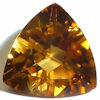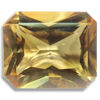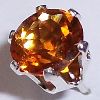
Citrine is a Quartz, just like Amethyst. In fact, nearly all Citrine sold in the gem market is actually heated Amethyst. This heat treatment is so common that it is normally not discussed, just assumed. That's not to say there is not natural Citrine, but it is quite uncommon and most is brownish and not as pretty as the heated material. Some specific mines in Brazil have slightly different trace elements in their source Amethyst and the heat treatment produces unusual colors that go from orange to dark brown, sometime even red. Madeira is a famous mine that produces a rich orangey color Citrine that is usually the most desired. Rio Grande is another mine that is known for extremely dark Citrine that goes from deep brown to red. Although never a true red, anything showing significant red is extremely rare and demands the highest price.
Quartz mines that produce Citrine can be found all over the world, but the most prolific and famous source is once again Brazil. Huge volumes are exported every year to dealers all over the world. Natural Citrine tends to have color zoning so be wary of any Citrines (or Amethyst) that seem to have completely uniform color. The price of Citrine is moderate and therefore the market doesn't necessarily attract a large quantity of synthetics, but they are there. There is plenty of synthetic Quartz in white, purple, and yellow that can be very similar to its natural counterpart. Be aware of this product because although it won't save you a lot of money, it could give you headaches in customer service. There are also other Citrine imitations including CZ, lab Sapphire and glass, but you'll have no problem recognizing them.
Citrine is often used as a low cost alternative to the November birthstone - golden Topaz. It is natural and imitates the color of all but the higher quality Imperial Topaz gems very well.





